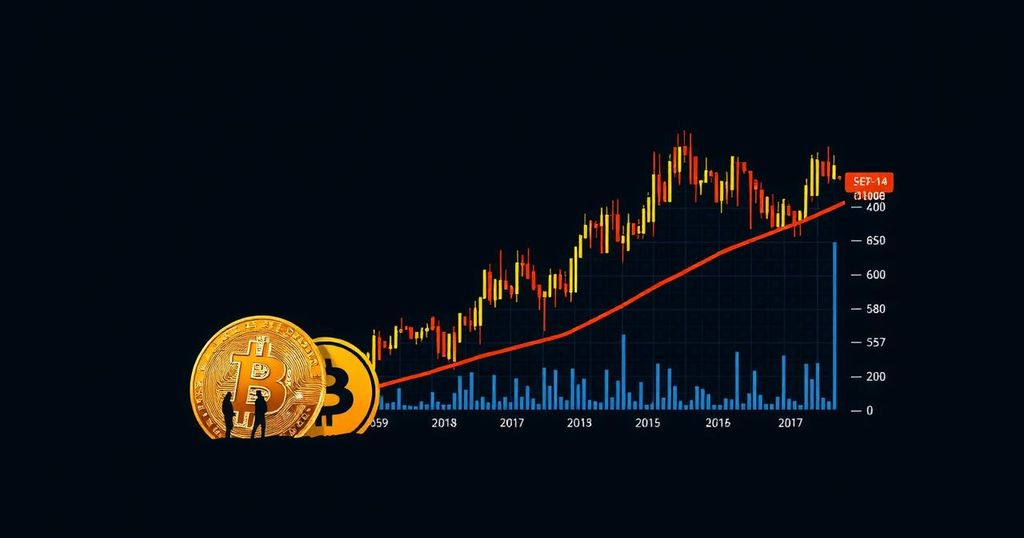Assessing Bitcoin’s Path: Will the Price Recover in September?
The recent volatility surrounding Bitcoin (BTC) poses intriguing questions about its potential recovery this September. On August 23, Bitcoin experienced a remarkable surge, increasing over 6% and climbing from $60,700 to approximately $64,450, following indications from Federal Reserve Chair Jerome Powell regarding anticipated interest rate reductions. This announcement catalyzed a significant influx into Bitcoin Exchange-Traded Funds (ETFs), fostering a surge in market optimism as bullish sentiments began to prevail.
However, this upward momentum proved to be ephemeral. By August 28, Bitcoin recorded its most considerable decline since early August, coinciding with a broader selloff in the cryptocurrency market. Initially plunging over 6%, Bitcoin found some stability around $59,760, while Ether also fell by more than 7%, ultimately recovering slightly to about $2,522. This downturn underscores the ongoing volatility inherent in the cryptocurrency space, despite the previously observed bullish activity.
Institutional participation indicates a strong interest in Bitcoin, evidenced by recent substantial net inflows into U.S. ETF products focused on the cryptocurrency. Last week, Bitcoin spot ETFs reported net inflows totaling $506 million, with BlackRock’s IBIT ETF alone accounting for $318 million of this sum, raising the cumulative value of such investment vehicles to $58.4 billion. Furthermore, inflows have persisted into the following week, as BlackRock’s Bitcoin ETF attracted an additional $224 million on August 25.
Nonetheless, concerns linger regarding possible sales of seized Bitcoin by the U.S. government, which could pose risks to the market. Despite this, optimism remains buoyed by statements from industry leaders such as Blockstream CEO Adam Back, who suggested that the recovering share price of MicroStrategy may signal a path for Bitcoin to ascend to $80,000.
Additionally, a notable correlation has emerged between Bitcoin and traditional equities like the S&P 500 and NASDAQ, as highlighted by the Pearson Correlation metric. This trend indicates that Bitcoin is increasingly regarded as a risk-on asset, moving away from its safe-haven status akin to gold. The influence of easing inflation and the Federal Reserve’s decision to maintain interest rates have cultivated a favorable environment for risk-oriented trading, leading to concurrent bullish performances in both Bitcoin and equity markets as investors seek greater returns.
Moreover, the open interest—representing the total value of all active derivatives contracts—diminished by 7.5% coinciding with Bitcoin’s recent price drop, suggesting a redirection of trading interest towards alternative cryptocurrencies. Despite this shift, Bitcoin’s dominance in the market surged above 57%, approaching its highest level since April 2021, indicative of its sustained relevance as a leading cryptocurrency.
Crypto analysts are observing a potential turning point for Bitcoin, as the BTC bull-bear market indicator indicates a shift back to a bullish stance, a precursor often preceding substantial price rallies. On Binance, trading patterns reveal that approximately 65.22% of top traders are positioning themselves long for Bitcoin, prompting observers to identify key support levels as Bitcoin’s price dynamics evolve.
In conclusion, while Bitcoin is not yet firmly entrenched in a bull market, the market appears to be stabilizing after a period of speculative excess that contributed to its earlier downturn. With a clearer outlook on demand-supply dynamics and signs of recovery amid institutional interest, there exists the potential for a rebound this September, contingent upon the broader market environment and the reactions to forthcoming economic indicators. It is essential for investors to remain vigilant and conduct thorough research before making any investment decisions, given the inherent risks associated with cryptocurrency trading.








Post Comment